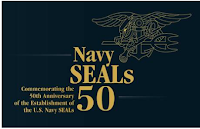
Navy SEALs trace their capability origins back to four formidable legacy units formed during World War II. They were the Amphibious Scouts and Raiders, formed in August 1942 for amphibious reconnaissance and commando operations in Europe and the South Pacific; Naval Combat Demolition Units (NCDUs), assault demolitioneers formed in June 1943 and trained almost exclusively for beach obstacle-clearance operations at Normandy and Southern France; Underwater Demolition Teams (UDTs), combat swimmers formed in December 1944 to conduct hydrographic reconnaissance and demolition of obstacles before amphibious landings throughout the Pacific; and the maritime operators of the Office of Strategic Services (OSS).
In early 1960, Chief of Naval Operations (CNO) Adm. Arleigh A. Burke directed the Pentagon’s Operational Navy (OPNAV) staff to organize new or existing Navy units for smaller conflicts. He directed the OPNAV staff to study the Navy’s options with respect to unconventional warfare. Among other things the staff suggested “… that the Underwater Demolition Teams and USMC reconnaissance units are organizations capable of expansion into unconventional warfare.” On Sept. 13, an Unconventional Activities Working Group was formally established and reported to the deputy CNO (Plans and Policy). This group was directed to investigate “naval unconventional activity methods, techniques and concepts, which may be employed effectively against Sino-Soviet interests under conditions of cold war.”
After considerable study within the Navy staff, it was determined that expanding the UDT mission would likely hinder their traditional and now doctrinal responsibilities to the Amphibious Force. Thus, it was considered that new units should be established possessing the characteristics of the UDTs, but incorporating new capabilities like those developed and practiced during the Korean War. Because the UDTs were doctrinally tied to Amphibious Force doctrine, they had been consistently denied opportunities to utilize U.S. Army and Marine Corps training schools, or given funding or authorizations to purchase the kinds of equipment needed for expanded naval missions originating from the sea, air, or land. It was intended, therefore, that these new SEAL units would not be doctrinally hindered and would be given freedom to establish a broader and more flexible mission.
Finally, and almost routinely, in a letter dated Dec. 11, 1961, the CNO officially authorized establishment of SEAL Teams in the Atlantic and Pacific Fleets with an effective date of Jan. 1, 1962. SEAL Team ONE was officially established under the command of Navy Lt. David Del Giudice, and SEAL Team TWO under the command of Navy Lt. John Callahan. Organization of these new units represented the culmination of almost four years of investigation into a special naval warfare capability within the Navy.
Read the very interesting, entire article on Navy SEALS here.

No comments:
Post a Comment
Enter your Comments below. Keep it clean.